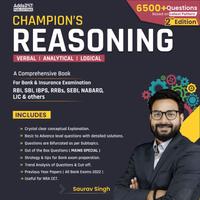Directions (1-3): In these questions, relationship between different elements is shown in the statements. The statements are followed by two conclusions. Give answer
(a) If only conclusion I is true
(b) If only conclusion II is true
(c) If either conclusion I or II is true
(d) If neither conclusion I nor II is true
(e) If both conclusions I and II are true
Q1. Statements: K>J≤A=B ; M>B≥C<D ; P>Q=M
Conclusions: I. A<P
II. J<C
Q2. Statements: K>J≤A=B ; M>B≥C<D ; P>Q=M
Conclusions: I. B>K
II. A≤K
Q3. Statements: U>V<W≥X ; Y≥W<Z ; P<R>Z
Conclusions: I. R>V
II.X≤Y
Directions (4-5): In these questions, a relationship between different elements is shown in the statements. The statements are followed by two conclusions. Give answer
(a) if only conclusion I is true.
(b) if only conclusion II is true.
(c) if either conclusion I or II is true.
(d) if neither conclusion I nor II is true.
(e) if both conclusions I and II are true.
Q4. Statement: D < C ≥ V ≥ F; G < D ≤ A
Conclusion: I. C > G II. A ≥ V
Q5. Statement: P > Y ≥ R ≥ E = K ≤ M ≤ L < O
Conclusion: I. L ≥ E II. P > K
Directions (6-7): In these questions, a relationship between different elements is shown in the statements. The statements are followed by two conclusions. Give answer
(a) if only conclusion I is true.
(b) if only conclusion II is true.
(c) if either conclusion I or II is true.
(d) if neither conclusion I nor II is true.
(e) if both conclusions I and II are true.
Q6. Statements: D < T ≤ Y = Q ≤ F ≤ P
Conclusions: I. T = F
II. F > T
Q7. Statements: B = U ≥ N ≤ L < G
Conclusions: I. B ≥ L
II. G > U
Directions (8-9): In each of the questions below, some statements are given followed by two conclusions. You have to take the given statements to be true even if they seem to be at variance with commonly known facts. Read all the conclusions and then decide which of the given conclusions logically follows from the given statements disregarding commonly known facts.
(a) If only conclusion I follows.
(b) If only conclusion II follows.
(c) If either conclusion I or II follows.
(d) If neither conclusion I nor II follows.
(e) If both conclusions I and II follow.
Q8. Statements: C > O = E ≥ A ≥ S < L
Conclusion I: O > S
II: E = S
Q9. Statements: U < W ≤ R > T ≥ P > J
Conclusion I: R > J
II: U < T
Q10. If the statement ‘F≤G=B<N≤H=T≥L>S<K’ is definitely true, then which among the following conclusions will be definitely false according to the given statement?
I. T>G
II. H≥K
III. B>H
IV. K>N
(a) Both II and IV
(b) Only III
(c) Only II
(d) Both III and IV
(e) None of these
Solutions
Solutions (1-3):
S1. Ans.(a)
Sol. I. A<P (True) II. J<C (False)
S2. Ans.(c)
Sol. I. B>K (False) II. A≤K (False)
S3. Ans.(e)
Sol. I. R>V (True) II. X≤Y(True)
Solutions (4-5):
S4. Ans. (a)
Sol. I. C > G (True) II. A ≥ V (False)
S5. Ans. (e)
Sol. I. L ≥ E (True) II. P > K (True)
Solutions (6-7):
S6. Ans. (c)
Sol. I. T = F (False)
II. F > T (False)
S7. Ans. (d)
Sol. I. B ≥ L (False)
II. G > U (False)
Solutions (8-9):
S8. Ans. (c)
Sol. I: O > S (False)
II: E = S (False)
S9. Ans. (a)
Sol. I: R > J (True)
II: U < T (False)
S10. Ans. (b)





 GA Capsule for SBI Clerk Mains 2025, Dow...
GA Capsule for SBI Clerk Mains 2025, Dow...
 The Hindu Review October 2022: Download ...
The Hindu Review October 2022: Download ...
 SBI Clerk Prelims Result 2025 Out, Direc...
SBI Clerk Prelims Result 2025 Out, Direc...







